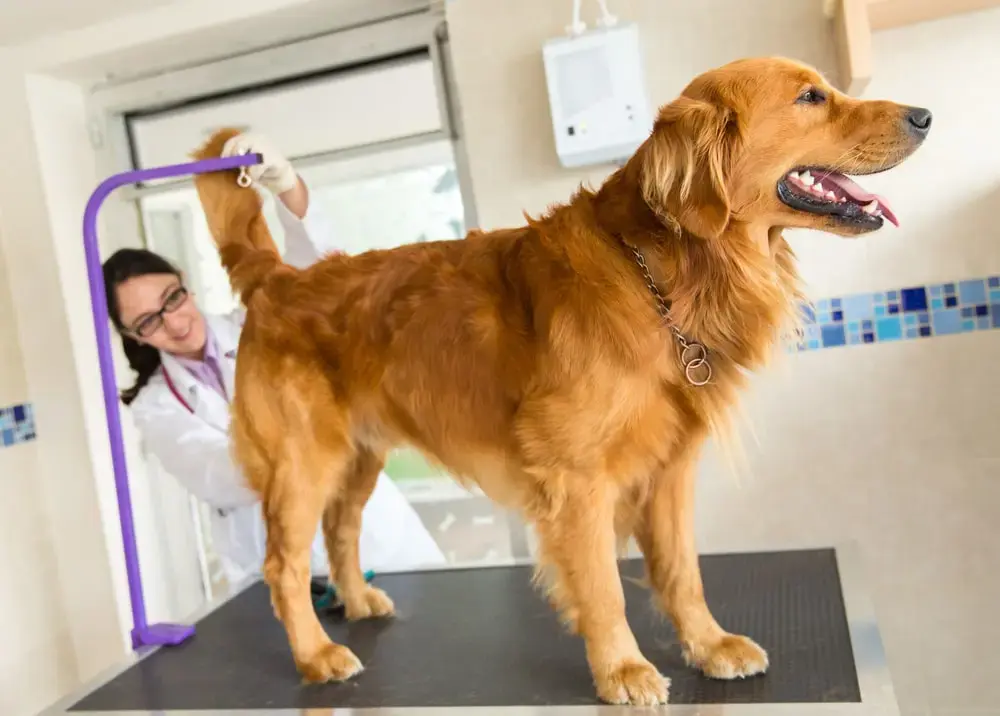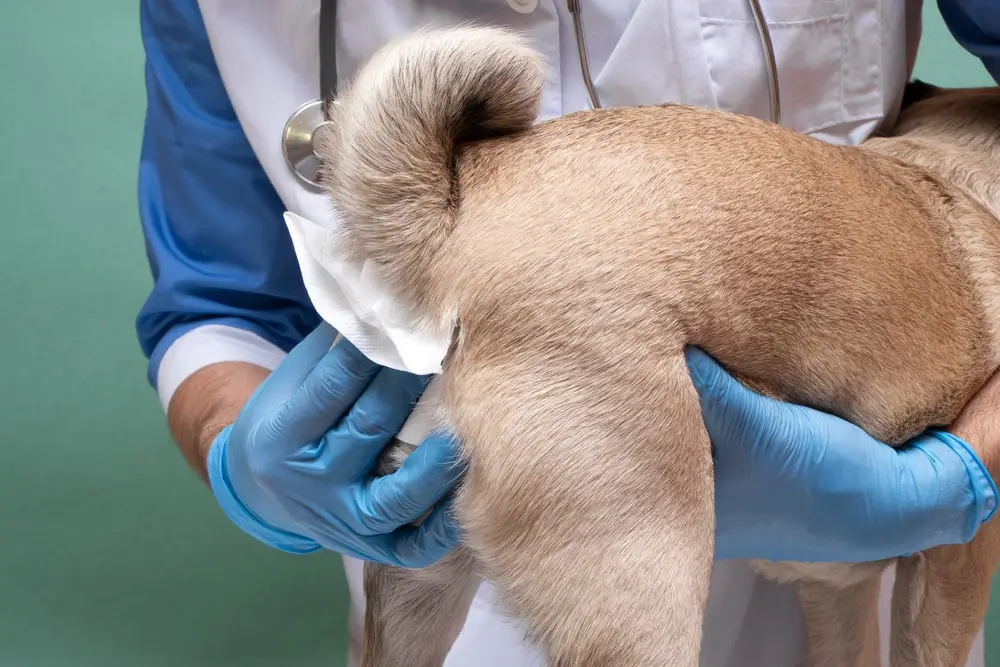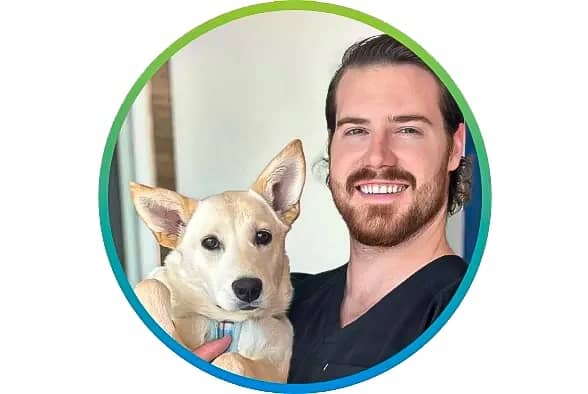PET HEALTH
When your dog exchanges a get-to-know-you sniff with another dog, they are likely checking out the unique odor coming from the dog’s anal glands.1 Anal glands are small sacs located on either side of a dog’s anus; they produce liquid to help with bowel movements and spread a dog’s scent.1
However, a dog’s anal glands can sometimes become blocked, requiring manual anal gland expression to release the fluid. Though some pet parents express their dog’s anal glands themselves, many opt to call an animal care professional to help with this sometimes unpleasant — and smelly — task.
Let’s break down what anal gland expression is, why it's necessary, how to do it yourself, and when to rely on a professional.
What Is Anal Gland Expression?
Anal gland expression happens when the anal glands release secretions. With dogs, it may happen when pressure is put on their anal glands. For example, dogs express their anal glands naturally when they have a bowel movement and even when they are startled or scared.
However, sometimes a dog’s anal secretions can thicken and may lead to the glands becoming enlarged or blocked.2 This could cause your dog discomfort due to pressure, irritation, or even an infection.
If this happens, the dog’s anal glands may need to be manually expressed to drain them. This can be done by veterinarians, dog care professionals, or even pet parents.
Why Do Dogs Need Their Anal Glands Expressed?
If your dog has blocked or impacted anal glands and they’re not expressed, it could lead to anal gland infections or something more serious like an abscess. Issues with their anal glands may also cause your dog some discomfort, prompting them to lick and scoot more. Bottom line, expressing anal glands can provide relief for your pup and help prevent worse issues from arising.
Signs of Anal Gland Issues
Scooting, excessive licking, straining while pooping, or blood in your pup’s stool can all be signs that they might have an anal gland problem. Sometimes a dog’s anal glands can have a fishy smell when they’re full. So a noticeable scent might also be a signal that expression is needed.
If you notice these symptoms, you may need to reach out to your vet to discuss next steps. Causes of anal gland problems in dogs can include your dog’s weight, food or environmental allergies, a lack of dietary fiber, and chronic issues like skin dermatitis and soft stool.3
How To Express Dog Anal Glands
Pet owners have some choices when it comes to expressing anal glands. You can manually express a dog’s anal glands at home or book an appointment with your vet or a groomer. As a general rule of thumb, expression doesn’t need to be done on a regular basis, only when you notice signs that it may be needed.
Dog anal gland expression at home
You may consider expressing your dog’s anal glands yourself if your dog is cooperative or they’re having an issue after vet hours. According to the American Kennel Club (AKC), there are several steps to expressing your dog’s anal glands at home.4 Let’s take a look:
- Prepare your materials. Since anal gland expression can get messy and smelly, consider wearing disposable gloves and a mask. Have wipes, paper towels, and petroleum jelly handy, and a washcloth with warm water ready for cleanup.
- Secure your dog in a comfortable position. Consider providing them with a toy or treat to distract them or ask someone to help you.
- Begin the anal gland expression. On one hand, apply petroleum jelly to your thumb and index finger and place them on either side of your dog’s anus where the anal glands are. If you picture the anus as a clock face, place them around the 4 and 8 o’clock positions. Anal sacs typically feel puffy and are about the size of a grape.
- Release the fluid. With your other hand, position a paper towel underneath the anal glands and in front of the anus to avoid getting yourself messy. Use your thumb and index finger to gently squeeze the anal glands together, allowing the fluid to release from both sides. Note that the liquid should be brown. If the fluid appears thicker than a liquid or a different color, you may need to consult a vet.
- Clean your dog up. The hard part is over! Using a washcloth and warm water, clean the area around your dog's anus, including the surrounding fur, to help get rid of any odor.
- Praise your pup! Give them a nice treat or special play time to reward their good behavior. This will help encourage them to continue to behave if you need to express their glands again.
When to call a professional for dog anal gland expression
If your dog’s anal gland expression isn’t something you feel comfortable doing, you may opt to call an animal care professional like a dog groomer or a veterinarian to perform the service. Dog grooming costs can land somewhere between $30 and $90, depending on the breed and size of your dog, and may include expression.
If you’re concerned about an infection, taking your dog to the vet for anal gland expression may be a good idea.5 They’ll likely be able to provide more insights into any underlying issues or causes of your pup’s discomfort. A professional can also give you insight into preventative measures to keep your dog’s anal glands healthy, such as managing your dog’s weight and diet, among other things.5
MetLife Pet Can Help You Take Care of Your Vet Bills
Although dog anal gland expression might seem like a normal hygienic pet care task, infections or abscesses can happen and lead to unexpected vet bills. To prepare for the future and provide peace of mind for you and your pup, you may consider investing in a dog insurance policy with award-winning6 MetLife Pet Insurance. Get a free quote today.
Protect your Pets
Dr. Hunter Finn is an integrative veterinary expert first, and social media star second. America’s favorite veterinarian owns Pet Method in McKinney, Texas, where he cares for pets while prioritizing their emotional well-being. When he’s not at his clinic, he’s starring in viral videos on TikTok (2 million followers) and Instagram (500K followers) — where he’s been known to snuggle puppies and conquer the latest dance trends.



